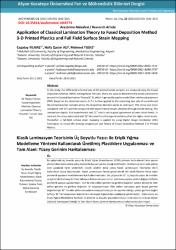Application of Classical Lamination Theory to Fused Deposition Method 3-D Printed Plastics and Full Field Surface Strain Mapping
Abstract
In this study, five differently oriented sets of 3D-printed tensile samples are produced using the Fused Deposition Method (FDM). Among these five sets, three are used to determine the elastic constant to be used in Classical Lamination Theory (CLT), which is generally used to model fiber-reinforced polymers (FRP). Based on the obtained results, CLT is further applied to the remaining two sets of unreinforced 3D-printed polymer samples where the deposition direction varies in each layer. The stress and strain calculated with CLT are then compared with experimental results obtained through tensile testing. The comparison depicts that experimental and CLT results are in good agreement at lower strain levels. In contrast, the stress calculated with CLT deviates from the experimental result at the higher strain levels.Thereafter, a full-field surface strain mapping is applied by using Digital Image Correlation (DIC) Techniques to reveal the damage progression and failure of Fused Deposition Method 3-D Printed Plastics.


















